
Art of Fighting is a fighting game series originally released for the Neo Geo platform in the early 1990s. It is the second fighting game franchise created by SNK, following the Fatal Fury series, and is set in the same fictional universe. The original Art of Fighting was released in 1992, followed by two sequels: Art of Fighting 2 in 1994 and Art of Fighting 3: The Path of the Warrior in 1996. A new Art of Fighting game is currently in development.
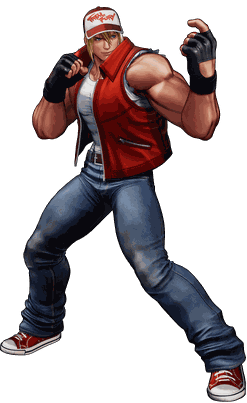
Terry Bogard is a fictional character created by SNK as the protagonist of their Fatal Fury series. Introduced in Fatal Fury: King of Fighters in 1991, he is an American fighter who enters the worldwide "The King of Fighters" tournaments to combat his father's murderer, Geese Howard. Following Geese's defeat in Real Bout Fatal Fury, Terry becomes the guardian of Geese's son Rock Howard. He is also a regular character in the crossover video game series The King of Fighters, where he continues participating in tournaments with his brother Andy among other Fatal Fury characters. He has also been a guest character in other games, including the Capcom vs. SNK series, Arika's Fighting EX Layer, Street Fighter 6 and Nintendo's crossover fighting game Super Smash Bros. Ultimate. In addition to video games, Terry has appeared in anime films based on Fatal Fury, and manga serialized in Comic Bom Bom.
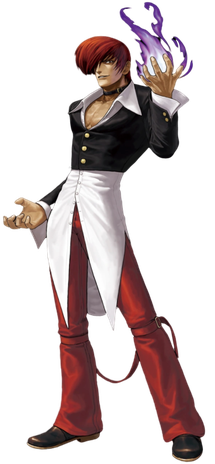
Iori Yagami is a character from SNK's The King of Fighters video game series. The character first appeared in The King of Fighters '95 as the leader of the Rivals Team, as the initial enemy and later rival of Kyo Kusanagi. Iori is the heir of the Yagami clan, who use pyrokinetic powers and sealed the Orochi devil along with the Kusanagi and Yata clans. Iori suffers from a curse – "The Riot of the Blood" – under which he becomes faster, stronger and wilder, exhibiting a deadly tendency to indiscriminately attack everyone in close proximity. In this state, Iori is commonly called "Wild Iori" or "Orochi Iori". Aside from the main series, Iori appears in several other media series, including spin-offs, crossover video games and comic adaptations of the series.
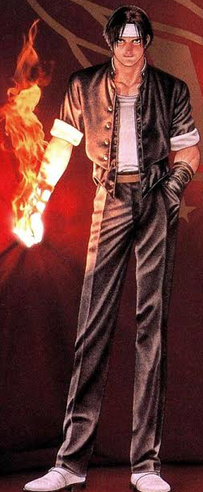
Kyo Kusanagi is a character in SNK's The King of Fighters series of fighting games. The character was first introduced in the 1994 video game The King of Fighters '94 as the leader of the Japan team from the series' title tournament. Kyo, heir to the Kusanagi clan, is first introduced as a cocky, delinquent high school student who has pyrokinetic powers. His clan is one of three who banished the legendary snake demon entity Yamata no Orochi. During the series' story, Kyo meets rivals and enemies who seek to take his flame abilities. Aside from the main series, Kyo appears in several crossovers and spinoffs with other games. He is also the central title character of the manga The King of Fighters: Kyo and video game adaptation with the same name, which center around his daily life.
Ryo Sakazaki is a video game character developed for the 1992 fighting game Art of Fighting from SNK. His name is most often written in kana, although in some games, kanji is used to write parts of his name. In the series, Ryo is a skilled martial artist who practices his family's fighting style, Kyokugenryu Karate, taught by his father Takuma before going missing. After his younger sister Yuri goes missing, Ryo and his best friend Robert Garcia go to Southtown to find Yuri facing several enemies across the game. While Art of Fighting follows Ryo's journey as a warrior to protect those he loves, he is also a regular character in the crossover series The King of Fighters, in which he participates in fighting tournaments to promote the Kyokugenryu Karate. He also appears in other SNK games as an older fighter nicknamed "Mr. Karate" inspired by his father Takuma. Additionally, he stars in manhua adaptations of several series and appears in the anime original video animation version of Art of Fighting.

Yuri Sakazaki is a fictional character from SNK's Art of Fighting series of fighting games. She first appears in the original Art of Fighting being kidnapped by Mr. Big, a criminal from the city of South Town. The players, Yuri's brother Ryo and his friend Robert Garcia spend the game searching for her. In the sequel, Yuri appears for the first time as a playable character, having been trained by her father Takuma in the art of Kyokugen Karate. Yuri has also starred in the anime adaptation of Art of Fighting, in which she reprises her role from the first game. Yuri was created originally as a weak damsel in distress who would become one of SNK's first female fighters following a positive response from Mai Shiranui in their related IP Fatal Fury. To overcome her weak body, SNK designers decided to make her mimic other fighters' moves, most notably the ones from Capcom's Street Fighter. Several actresses have shared their talent into voicing the character since her debut.

KOF: Maximum Impact (KOFMI) is a 2004 fighting video game developed by Noise Factory and published by SNK Playmore for the PlayStation 2. An enhanced version was released in 2005 for both the Xbox and PlayStation 2, subtitled Maniax. Marketed as a spin-off of SNK's major fighting series The King of Fighters (KOF), whence many of its characters originate, Maximum Impact also contains elements of the Fatal Fury and Art of Fighting series. Maximum Impact is the first 3D fighter made by SNK since 1999's Fatal Fury: Wild Ambition and Samurai Shodown: Warriors Rage.
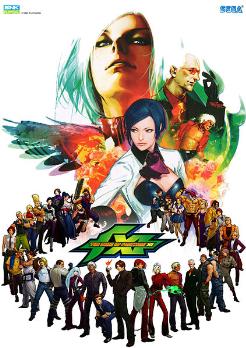
The King of Fighters XI(KOF XI) is a 2005 2D fighting game produced by SNK Playmore. It is the eleventh installment in The King of Fighters series following The King of Fighters 2003. Originally released as a coin-operated arcade game for the Atomiswave platform, a home version for the PlayStation 2 was released in Japan in 2006, followed by releases in the PAL region and North America in 2007. It is the second The King of Fighters game to not run on the Neo Geo following its predecessor, The King of Fighters Neowave and also the first major canonical entry to not be named after its year of release.

The King of Fighters 2006, known in Japan as KOF: Maximum Impact 2, is a 3D fighting video game produced by SNK Playmore and released for the PlayStation 2 in 2006. An updated version was released on both PlayStation 2 and arcades in Japan under the title KOF: Maximum Impact Regulation A in 2008. It is the sequel to KOF: Maximum Impact (2004), which itself is a spinoff of The King of Fighters (KOF) series.

Fatal Fury: King of Fighters, known as Garō Densetsu: Shukumei no Tatakai in Japan, is a 1991 head-to-head fighting game originally released by SNK for the Neo Geo arcade and home platforms. Fatal Fury was ported to other platforms including Super Nintendo in 1992 and Sega Genesis in 1993, published by Takara. Fatal Fury was SNK's first fighting game for the Neo Geo system and served as the inaugural game in their Fatal Fury series. The three playable characters are the Bogard brothers Terry and Andy alongside their friend Joe Higashi. In the story they oppose their nemesis Geese Howard, the host of "The King of Fighters" tournament where the player must use to defeat enemies until becoming the champion and reach Geese.
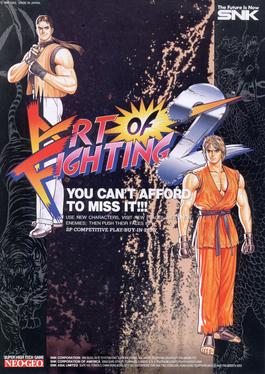
Art of Fighting 2 is fighting game developed and released by SNK first released in arcades on 3 February 1994. It is a direct sequel to Art of Fighting involving both new and returning characters. They all fighting each other in the King of Fighters tournament, with Ryo Sakazaki and his friends working together to take down the mafia host Geese Howard whose forces manipulated them in the first Art of Fighting game. It retains most of the characters from the first Art of Fighting characters rather than just Ryo and Robert Garcia. The gameplay remains faithful to the original Art of Fighting including Desperation Moves and taunts that are use strategically. but this time playable This game was promoted with The King of Fighters '94 released in the same year by the company. It was ported to the Neo Geo AES, Neo Geo CD and Super Famicom. It would be later ported as part of the entire Art of Fighting trilogy for more modern consoles.

The King of Fighters '94 is a 2D fighting video game produced by SNK in 1994, released on the Neo Geo MVS arcade system, AES and CD home consoles. It was the first game in The King of Fighters series; KOF '94 is a crossover featuring characters from SNK's fighting game properties Fatal Fury and Art of Fighting and also includes revised versions of characters from their older games Ikari Warriors and Psycho Soldier, as well as original characters created specifically for the game. The plot revolves around the eponymous tournament created by a criminal, Rugal Bernstein.
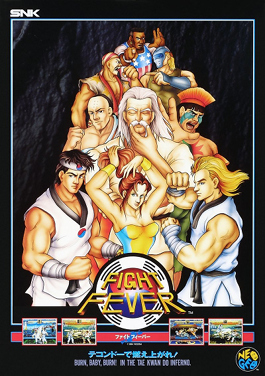
Fight Fever is a 1994 2D fighting video game for the Neo Geo MVS arcade system. It is the first South Korean developed Neo Geo title ever officially released, as well as the first game developed and released by the Korean publisher of SNK games, Viccom (빅콤). A release for Neo Geo CD was also showcased but did not occur.

The King of Fighters XIII(KOF XIII) is a 2010 fighting game in The King of Fighters series, developed by SNK Playmore, coming a year after The King of Fighters XII (2009). Released on Japanese arcades, it was ported to Xbox 360 and PlayStation 3 globally in 2011, and an updated version for arcades followed in 2012 subtitled Climax. The game is set after the events of The King of Fighters XI (2005) and is also the conclusion of Ash Crimson's story arc, which started in The King of Fighters 2003. It follows another King of Fighters tournament secretly hosted by Those From the Distance Land, the organization behind the events from the two prior games that are trying to break the seal of the demon Orochi and take its power.

Art of Fighting is a fighting game released by SNK on arcades on 24 September 1992. It originally released for the Neo Geo platform in the early 1990s. It was eventually ported to the Neo Geo AES, Neo Geo CD, PC Engine Arcade CD-ROM², Sega Genesis, and SNES. The game follows tow Karate users known as Ryo Sakazaki and Robert Garcia who travel to fight criminals from the Southtown city in order to find Ryo's missing sister Yuri. The game employs special moves and stronger Desperation Moves that can be performed strategically by filling the player's energy bar and removing the enemy's by taunting them.

K Dash is a character from The King of Fighters fighting game series developed by SNK. He debuted as the leader of the Hero Team in The King of Fighters '99, released in 1999. He often stars as the reluctant hero. K′ is a young man who lost all his memories when the NESTS syndicate captured him and injected the DNA of Kyo Kusanagi to replicate his pyrokinetic abilities. While rebelling against organization, K' forms multiple bonds with other NESTS agents. Aside from the main series, K' also appears in several other media series, such as spin-offs and crossover video games, as well as printed adaptations of the series.
Nobuyuki Kuroki is a Japanese game designer working for SNK. He did art for several Art of Fighting and Fatal Fury games and took a bigger role in The King of Fighters XIV and Samurai Shodown.
Hiroaki Hashimoto, also simply nicknamed Hiroaki, is a Japanese illustrator and character designer for SNK and other companies.

The following is a list of video game characters featured in the Art of Fighting fighting game series developed by SNK. The Art of Fighting series serves as a prequel to the Fatal Fury series, with the three games taking place between 1978 and 1980, over a decade before the events of Fatal Fury: King of Fighters. The initial two games are set in South Town, the same setting as the Fatal Fury series, as martial artists Ryo Sakazaki and Robert Garcia face several foes after Ryo's sister went missing. The second Art of Fighting 2 is a direct sequel starring far more playable characters with the leads alongside Yuri and Ryo's father Takuma participating in the King of Fighters tournament in order to have revenge against the host Geese Howard for orchestrating Yuri's kidnapping. The third Art of Fighting game takes place in the fictional Mexican town of Glasshill Valley as several fighters travel around the area for their own purposes with Ryo and Yuri searching for the missing Robert.
















